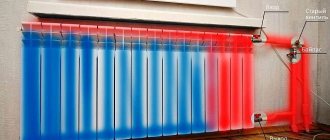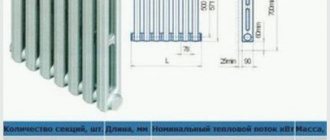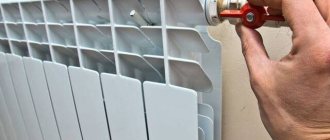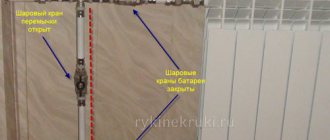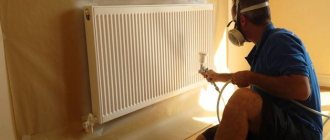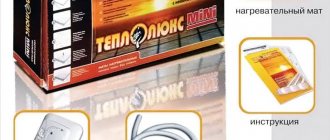What can an airy radiator cause?
If there is an air lock in the radiator, it begins to heat worse.
The larger the air volume inside the sections, the worse they heat. For aluminum radiators, air does not pose a particular danger, unlike steel and bimetallic ones with a steel interior
Metal corrosion occurs at the point of contact between air and water, which is why it is so important to identify and remove air pollution in a timely manner.
If air appears in the system, it means it can accumulate in the pump, pipelines, heating boiler, etc. this leads to reduced service life.
When air accumulates in the pump, it begins to work with increased power, overheat and wear out heavily. If air gets into the boiler, the water in the heating system will boil, which can lead to a break.
We hope that the article was useful to you and we answered the question of how to get rid of air in a heating radiator. Don't forget to share the post on social networks
Places of formation and elimination
It is necessary to bleed air from the battery if there is no doubt about its presence. Gasping is indicated by unexpected gurgling sounds. In addition, the owner begins to notice that the heating is uneven. To restore radiator circulation, air must be removed.
If the system is completely aired, first determine where the plugs are forming by tapping the pipes with a hammer. The sound is stronger and more sonorous in the places where the traffic jam occurs; the areas will also have a lower temperature. Having found a place with air, you need to do the following:
- Prepare a key or screwdriver, as well as a basin for water. The thermostat is opened to the maximum level, then the container is placed.
- Open the valve, making sure that all the water from the inside will flow into the substituted container. You can additionally place rags around.
- The valve must be kept open until all the liquid has drained. A slight hiss indicates air escaping. This means that the manipulations are performed correctly.
- If after the procedure the pipes still do not heat up well, then they need to be blown out and washed - the accumulation of rust inside can also cause air to appear.
In addition to mechanical air removal, there is automatic air removal.
If such manipulations do not improve the situation, then check the filling level of the system. Often, plugs occur in the bending area of pipes, so during installation, their dimensions and direction are usually observed. If in some place the slope differs from the planned project, additional drain valves must be installed.
More often, plugs appear in aluminum radiators, since this material is not of particular quality. Aluminum reacts with the coolant, the result is the formation of gases that must be constantly removed from the system. Here it is usually advised to replace aluminum options with higher quality ones with an anti-corrosion coating, and also not to forget about air vents.
Little things and nuances
If, when installing the heating system, the craftsmen were lazy and did not install a special valve on the heating radiator, then you yourself will have to carry out the simple procedure of bleeding air from the battery, but in a slightly different way.
To do this, you need to have a gas or adjustable wrench with you, with which you begin to very slowly unscrew the plug. If the screw cap on a cast iron battery does not come off, apply thread lubricant directly to the thread itself and try again after a certain time.
Appearance of the Mayevsky crane
Next, proceed in the same way as with a regular tap. When screwing the plug into place, do not forget to wrap flax or FUM tape around the thread.
In private houses with an autonomous heating system, it is sometimes necessary to drain the water using an expansion tank, which is always located at the highest point of the heating system.
After the water has been drained, wait a while and then unscrew the tap on the expansion tank. Almost always the plug comes out on its own when the radiator temperature rises. If these actions do not lead to the desired result, bring the water in the heating system to a boil and then the air lock will definitely come out.
Also keep in mind that an air lock can form in places where the pipeline is bent; for this reason, when installing a heating system, it is necessary to maintain the optimal distance for the direction of slopes when laying out the pipeline.
If the actual slope of the pipe differs from the designed one or the pipeline makes a loop, then it is necessary to install additional air bleed valves.
Modern manufacturers of heating radiators are sometimes not very conscientious in their production, and as a result, we receive a low-quality radiator, which can bring additional headaches. And all because, no matter how much you bleed the air from a battery that is not made according to standards, the air in it will be endless. Because the radiator material itself promotes the formation of gases. There is only one solution to this problem - buy a new high-quality battery.
If you prefer the video instruction format, watch the video below. Everything is shown there step by step.
https://youtube.com/watch?v=NMl6uL9AFP8
If you are afraid to do this work yourself, we recommend turning to professionals. Write in the form at the bottom right of this page and the specialist will calculate the cost of the work and advise you on important nuances.
We hope that the material was useful to you. Please click on the social media buttons below.
I wish you a warm home and no air-filled radiators!
Recommendations for bleeding air
If the heating system includes automatic devices, excess air in it is eliminated without human intervention, subject to proper installation. However, in order to save money, some equip their heating with mechanical devices.

In this case, containers for the coolant are pre-prepared. After this, the heads on the exhaust valves are unscrewed. Then it is necessary to observe how the liquid leaves the system.
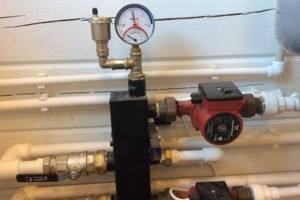
Hissing will indicate the presence of air bubbles. When the noise stops and the stream becomes smooth, the valves can be closed. Then all that remains is to return the coolant to the circuit.

How to properly bleed air from a battery
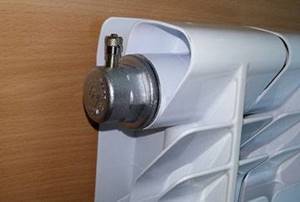
In the gravity system of a private house, all bubbles themselves exit through the expansion tank located at the highest point.
In city apartments, an air vent is installed on each radiator:
- Manual (Maevsky crane).
- Automatic valve.
Depending on what is installed, the operating technology will change.
Aluminum, bimetallic or cast iron
Aluminum is not the most suitable material for heating. It actively enters into chemical reactions and releases hydrogen. But due to its modest price and good thermal conductivity, it is often used. To combat the shortcomings of aluminum, it is coated from the inside with a layer of a special film. But over time, it stops working, and hydrogen inevitably begins to be released.
Bimetallic radiators are another invention that improves the quality of heating devices. Where there is contact with the coolant, a different metal is used. And the fins are made of aluminum.
If a thermostat is installed on the battery, you just need to periodically open it and wait until the air comes out. The process of bleeding air from bimetallic batteries is no different from working with an aluminum radiator.
Mayevsky crane

This is a small, convenient air vent located on the side of the battery.
If there is a Mayevsky tap on an aluminum, bimetallic or cast iron radiator, you need to prepare a screwdriver or pliers, as well as a water container.
Use a screwdriver to unscrew the tap. If there really was a plug, air will begin to escape and a characteristic hissing sound can be heard.
You first need to place a water container under the tap - the fact is that after a little while the air will begin to come out along with drops of water, but it is too early to close the Mayevsky tap. The air is considered completely deflated when a steady stream of water flows from the hole.
How long the procedure will take will depend on what volumes of gas have accumulated in the system. Air usually comes out from one battery within 5 - 7 minutes. It sometimes takes half an hour or more to de-air the entire system.
With high pressure, the liquid can splash in different directions. A simple cloth hung on the radiator so that water flows down it into a bucket will help protect repairs and furniture.
Without Mayevsky crane
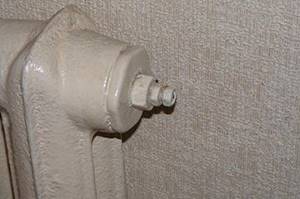
Old cast iron batteries used to have a regular plug installed.
It had to be unscrewed (which in itself is sometimes difficult), first blocking the access of the coolant to the radiator.
If this is your case, you will need to approach the work thoroughly. Stock up on rags, a basin or bucket.
And in order to unscrew the plug you will need an adjustable wrench. The problem is that such plugs were screwed onto the tow with paint, and sometimes they were well filled in during painting of the batteries. A little kerosene will help dissolve the paint. It needs to be applied to the junction of the plug with the radiator and wait 15-20 minutes. Even after this, it may be necessary to apply considerable force to move the plug along the thread.
Craftsmen of past years simplified their task by installing a regular faucet on such plugs. They spoiled the view, of course, but it became easier to bleed off the air.
After the procedure, the plug is wrapped with FUM tape and inserted into its original place.
If you do not calculate the effort and unscrew the plug completely, hot water will pour out! This is why it is important to close the riser - if this is not done, it is almost impossible to insert the plug back
Automatic air vent
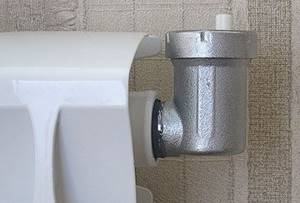
In order not to burden yourself with air bleeding procedures, you can install an automatic valve.
They are equipped with a float that tightly closes the discharge hole as long as there is water in the system.
When gas leaks out, the float lowers and opens the hole - the air comes out.
These devices have a weakness - they would prefer to work with very clean water, which does not exist in centralized heating systems. Therefore, the automatic mechanism must be installed together with filters. But this does not guarantee complete safety of the air vent. It may need to be cleaned or replaced periodically.
If, after several years of proper operation, the automatic valve begins to “dig”, the problem is either in the sealing ring (you need to change the gasket or wrap FUM tape on the threads), or the needle of the mechanism is overgrown with salts (you will need to remove the cover and clean the needle).
Removing air lock
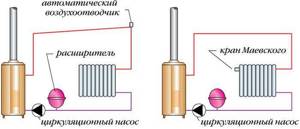
You can bleed air from closed-type heating through an air vent at the top point of the system or through taps on the radiators
If the heating is designed correctly, then how to bleed air from it will not be difficult. It can be arranged so that the release of accumulated air will occur automatically as it accumulates. For this purpose, special devices are used - air vents installed at critical points. In other cases, it is necessary to acquire skills on how to bleed air from the heating system manually.
What matters is:
- open or closed type of system;
- natural or forced coolant circulation;
- upper or lower pipe routing option;
- Are the horizontal slopes of the pipes observed?
Radiator drain valve

The procedure for removing air accumulated in the battery through the Mayevsky tap is not difficult
In apartment buildings, residents do not have a question about how to bleed air from the heating; specialists from the management company should worry about this. Although in old five-story buildings the heating is arranged in such a way that it is only possible to bleed air from it through a radiator in the apartment on the top floor, and the residents themselves periodically have to do this. The problem of air venting seems more acute for owners of private houses with autonomous heating - it is periodically necessary to bleed the air. To bleed air from a water heating radiator, a needle air valve, the so-called, is used. Mayevsky crane. Such a device is installed at the upper end of the radiator battery, instead of a plug. Sometimes it is also used to bleed air from a heated towel rail pipe. Different models of Mayevsky taps are slightly different, so before you bleed air in heating radiators, you need to read the instructions. Open the tap valve either with an open-end wrench, or with a regular screwdriver, or simply with your hand.
Let's look at how to release an air lock from a heating radiator using a Mayevsky crane installed on it:
- prepare tools (wrench or screwdriver) and a container for collecting water;
- open the thermostat completely, then unscrew the Mayevsky tap half a turn;
- air will begin to escape through the valve with a slight hiss;
- place the container and keep the valve open, since you need to bleed air from the heating radiator until water flows;
- When a dense stream of water appears, you can turn on the tap.
Bleeding air through the expansion tank

Equipping the expansion tank with a semi-automatic float mechanism will allow you to maintain a constant water level
In private homes, the design of heating systems varies, depending on the layout of the buildings. For different types of systems, appropriate expansion tanks are used - open or closed. Therefore, individual homeowners often have to think about whether it is more expedient to bleed air from the heating radiator or through the expansion tank.
In an open type system, air bubbles have a free exit through an expansion tank installed in the attic. If the heating is working normally, there is no need to bleed air from the system, since it comes out on its own. But the liquid gradually evaporates, and the water level in the open expansion tank can drop so low that an air lock appears in the upper part of the supply pipe. In this case, the circulation of the coolant will slow down or stop completely, and in this situation we should already be talking about how to bleed air from the heating system.
To expel the air lock, you can add water to the expansion tank from above, but it is better to replenish the volume of liquid in the system through the lower tap connected to the water supply. The water coming from below will fill the void in the pipe and push the air out through the opening of the expansion tank.
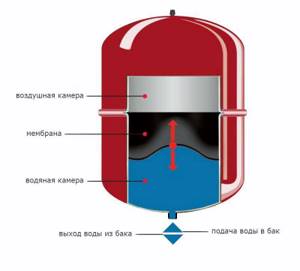
An elastic membrane inside a closed expansion tank compensates for coolant pressure drops
In closed systems, membrane expansion tanks are used. Sometimes the membrane ruptures in them, and then air enters the system. If it can be determined that the cause of airing is a faulty expansion tank, it will have to be replaced. But before starting repairs, before draining the water from the heating system, you need to prepare everything you need so as not to leave the house without heat for a long time.
Varieties
There are three types of air vents, differing in operating principle and design:
1. Mayevsky manual tap . This is the simplest device that is controlled manually. If uneven heating of the radiator is detected, the tap can be opened with a key or any screwdriver, and then, as air leaves the radiator, turn the tap in the opposite direction.
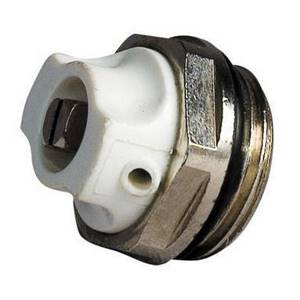
The photo shows a Mayevsky manual type crane
2. Automatic tap . The difference between an automatic crane is the absence of manual control of its operation. Its design and operating principle are somewhat different from the functioning of a manual crane. An automatic faucet is made of brass in the form of a cylinder, but there is no needle valve in its design. Instead, a plastic float is used. How does an automatically controlled Mayevsky crane work? A plastic float, depending on the presence of air in the system, moves inside the tap and controls the opening and closing of the valve. Everything happens without human intervention.

The principle of operation of the Mayevsky automatic crane is visually demonstrated in the photo above.
All automatic taps have the ability to be manually controlled, which can be used when the passage opening becomes clogged.
3. Crane with built-in safety device . For this type of Mayevsky crane, the principle of its operation is somewhat different from the usual bleeding of air. The safety valve is able to control the coolant pressure in the system. If the coolant pressure exceeds the limit value, reaching 15 atmospheres, the valve will operate and begin to forcibly bleed the coolant from the heating system. This prevents damage to individual elements of the system in the event of sudden water hammer.
It is especially important to install air vents with safety valves in heating systems made of polypropylene and metal-plastic pipes, which may not withstand high pressure.
Why are air masses in a heating radiator dangerous?
Characteristic gurgling sounds that will come from the battery can indicate that air bubbles have entered the heating system, and the surface of the radiator itself will practically not heat up.

The danger will be that oxygen accelerates corrosion, which negatively affects the integrity of the entire system. The reasons for its entry may be different, but often we are talking about significant violations of the installation work of the system itself, the use of low-quality coolant.
Reasons for the appearance of air in the heating system
Without exception, all residents of our country are familiar with the term “air jam” firsthand. Such phenomena are extremely common in the spring, immediately after the boiler houses have been launched, which is accompanied by the supply of coolant to the apartments.
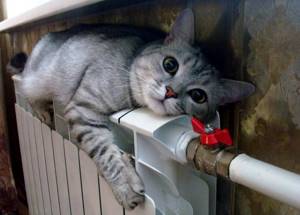
Often, residents of upper apartments observe a situation where the upper part of the battery remains cold, while its lower part practically does not heat up. The problem is the accumulation of air in heating radiators. There may be several reasons:
- Independent connection of a thermal water floor system, which is not allowed in old-style apartments. The pipes in it will be at different heights.
- Air intake systems can also fail.
- The pipe joints were sealed incorrectly, which resulted in a coolant leak. Such leaks are difficult to notice, and hot water may even evaporate. Loose seams are a common cause of air bubbles getting inside the system.
- The filling of the system was carried out with violations. Filling is progressing slowly as the pipes have been empty for some time. Thus, air is bleed from the system at the same time.
- Air jams can also form due to the release of bubbles from the heated coolant. They will strive to get to the top part of the system - to the upper floors of apartment buildings.
- If there is insufficient pressure inside the system. Low pressure will lead to the formation of voids that will fill with air.
- Failure to comply with the direction and magnitude of the slope used when laying the pipeline.
- Any disassembly or assembly of the system will be accompanied by airing.
Reasons for the formation of an air lock in heating
Such a malfunction results from:
- Incorrect installation. If the pipes are not laid out with a constant slope, then the curved sections of the system will become places where air pockets will form regularly.
- Violations of tightness. In this case, air will enter through various connections or cracks in the pipes.
- Violations in the installation of air vents. Or clogging of device elements with solid particles.
- Ignoring the rules for preparing the system for the heating season.
- Repair work or prevention.
- Replenishment of volume, since the liquid contains a certain percentage of gas bubbles.

Consequently, the formation of a plug may be a consequence of natural causes or installation errors. Knowing the cause will allow you to choose the optimal method for troubleshooting.

Types of air vents and their installation locations
Also called a needle radiator valve, it is distinguished by its simplicity and durability, and is made of brass. The design involves a body and a conical screw. All parts fit tightly against each other and reliably hold water in the battery. When opened, air is released from a small hole on the side. The Mayevsky tap comes in different designs and, depending on this, can open differently.
Installation of such a crane does not require special professionalism. The main thing is to choose the right size faucet. Before installation, you need to drain the water from your battery, and then unscrew the plug in the radiator cap. For greater reliability, you can wrap FUM tape around the thread.
Automatic air vent.
This device automatically removes all gases accumulated in the pipeline, and is therefore undoubtedly more convenient than the Mayevsky tap. Made from bronze and stainless steel. It can be installed with a shut-off valve, which is needed to easily replace the air vent.
An automatic air vent is installed in the highest places of the heating system, since gas is lighter than liquid and rises to the top. Experts recommend installing a diverter behind the boiler, on the collectors and at the highest points where the pipes pass.
Prices for such equipment start at 300 rubles.
Air separator.
The operating principle of this device is based on separating gas from liquid and removes all microbubbles and oxygen dissolved in water from the system. The design uses special PALL rings, and all microscopic air bubbles are caught by their surface. In addition to catching bubbles, separators also catch dirt circulating in the system.
A separator is installed immediately after the boiler, since most of the oxygen is released from the water when heated and is best removed immediately.
Such equipment can be called advanced and the prices for it are correspondingly higher - from 10 thousand rubles.
Multi-stage system.
It is considered the most effective method of removing air accumulated in pipes and radiators. It consists in combining several types of devices in one circuit. Typically looks like this:
- Mayevsky's battery-powered crane.
- Automatic air vent next to the boiler.
- Air vents on the manifolds.
- Separator after the boiler.
The best option usually costs more than the others, and our case is no exception. The exact price is determined from a specific scheme.
Automatic air vent
This is a metal unit mounted on a radiator, which is designed to automatically remove air without human intervention. Inside there is a float and a needle valve. These two mechanisms create the balance of the air vent. In working condition, the body is filled with water, the float is raised, the valve is closed. The resulting air gradually enters the device, the float, under its influence, lowers and opens the valve, which allows the air to escape. These devices are usually installed at the highest points of the heating system, where the largest amount accumulates.

Automatic air vent
These units can be straight or angular, depending on the battery configuration. It is important that the outlet should always point upward.

Automatic corner air vent
The automatic air vent is installed in two ways.
- Direct installation into thread.
- Installation via shut-off valve. This valve allows the air vents to be removed without shutting down the system. They are removed for periodic cleaning, since in a state contaminated with impurities it stops working correctly.
To avoid problems when installing this mechanism, a number of rules are followed. You can only unscrew and tighten it with a wrench, since when using an adjustable wrench, you may miscalculate the force and it will crack. You cannot hold on to the air vent housing during work - it can break.

Automatic air vent on battery
The price of an automatic unit is from 300 to 500 rubles, which is much more expensive than its mechanical counterparts. Well-known companies producing air vents are Danfoss and Wind.
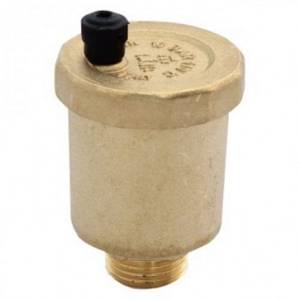
Danfoss automatic air vent
Bottom Filling with Administrator Access - Air Lock Removal
It’s one thing if the problem can only be solved from your own apartment or by contacting specialists. It’s another matter if you can play the role of a specialist yourself, for example, by gaining access to the basement.
The solution to the problem in this case is as follows:
- Before removing air from the heating system, it must be bypassed, for which the heating valve is first closed and the sewer discharge located underneath is opened;
- After completing the previous steps, the system should be given about 5-10 minutes to release air;
- If the desired effect is not achieved, the system must be turned in the opposite direction;
- After bleeding the air, you need to close the vent and return all valves to their original positions so that the heating circuit continues to function as normal.
Individual risers with which problems have arisen can also be transferred from the basement level. To do this, it is enough to close the valve of one of the connected risers and open the discharge. The probability of successful bleeding of air in this case is quite high, and if one of the risers is used as an idle pipe, then the work will certainly be crowned with success.
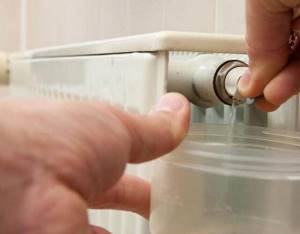
Even if plugs are installed on the risers instead of vents, there are a couple of ways to get rid of an air lock in the heating system:
- The first option is to shut off both risers, reset them, and then replace one of the plugs with a ball valve with a male-female thread. Of course, this option will require the faucet itself - but its cost is low, and such costs are certainly worth it so that the heating system can continue to operate.
- For the second option, you need to close the valves located on the risers, and then unscrew one plug. The riser is put into reset mode, stops, and then the previous operations are repeated in reverse order. This method of bleeding air can only be used when the coolant temperature is below 45 degrees - otherwise the person performing this work may be seriously burned.
Bleeding air from heating devices
Before bleeding air from the radiator and from the system, you need to familiarize yourself with the features of this procedure and prepare tools and materials
It is important to understand how to bleed air from a battery correctly. You need to have a special key at your disposal that will help open the air valve on the battery
A radiator wrench is best suited for this type of work - you can buy it at a hardware store.
If you have to work with a modern battery, then a simple screwdriver will do. You should also prepare a container for draining the coolant and several rags in case of an unforeseen situation.

Instructions for properly bleeding air from the battery look like this:
First, they inspect the battery and find a small valve (Maevsky tap). It is located at the top of the device; sometimes there are several such devices. Turn off the tap until air hisses.
You must act carefully and smoothly. Place a container under the valve. You should wait until all the accumulated air comes out. This is evidenced by a thin stream of water that has stopped bubbling.
According to some experts, you need to drain approximately 2 - 3 buckets after the coolant begins to drain without gases. This is necessary for reinsurance, so as not to carry out this procedure again. The valve is screwed back on.
In addition to the Mayevsky tap, you can bleed air from the battery using automated air vents. They are intended for heat supply systems and remove plugs independently.
These devices are compact and reliable, but care must be taken, because the valves are unattended and even a slight disruption of the process can lead to flooding of the basement or attic.

Sometimes situations arise when, during the installation of the heating system, special products designed to eliminate air pollution were not installed. To release excess air from the device, you need a gas or adjustable wrench to unscrew the plug.
This work needs to be done slowly. If the plug does not unscrew, and such situations most often occur with cast iron radiators, a special lubricant should be applied to the threads. After a while the attempt is repeated. After you have managed to unscrew the plug, proceed in exactly the same way as with a regular tap.
At the end of the work, the plug is returned to its place, not forgetting to wrap flax or FUM tape around the thread, which will prevent leaks and ensure the tightness of the connection.
If air has collected in the heating system of a private house, the coolant is drained using an expansion tank. This container is located at the highest point of the heat supply structure. After draining the water, wait a little, then unscrew the tap on the tank.

As a rule, when the temperature in the battery rises, the plug is removed on its own. If the above actions are unsuccessful, then the water in the heating circuit must be brought to a boil and then the air will certainly escape.
Knowing how to bleed air from the radiator and system, you can avoid many problems. For preventive purposes, a similar procedure should be carried out before the start of the heating season. According to experts, two times (for verification and control) will be enough. If defects or breakdowns are found in the structure, then the number of descents may be greater.
How to avoid air locks
If the heating main is made in accordance with the requirements of GOST and TU (technical conditions), then the appearance of air masses in it is minimized. Another condition to prevent this phenomenon is the correct process of filling the system with water. It has its own characteristics for open and closed heating circuits.
Open circuit
The diagram of an open heating circuit gives an idea of the order in which such a system should be filled with water after flushing. At its highest point there is an expansion tank, and in it there is a special pipe. Its purpose is to protect the highway from overflow.
Such a contour is filled in as follows:
- At the lowest point there is a shut-off valve, through which cold coolant is supplied to the circuit.
- The heating boiler is switched off before filling the system.
- After this, filling of the contour begins. The incoming valve at the bottom of the circuit opens in such a way that the coolant flows in very slowly. In numerical terms, this is expressed in a ratio of 1:3. This means that the valve only needs to be turned back one third of the inlet diameter of the pipe.
- Filling continues until the coolant flows through the overflow hose. Then the water tap is closed.
- Then, air vents are opened on all radiators to ensure high-quality filling of the system.
- The boiler is reconnected. It is advisable to open its taps very slowly.
- The next step is to add coolant at the same slow pace, with the expansion tank filled to 60-70%.
- The operation of the heating system must be checked.
- The boiler is turned on for heating.
- Radiators and pipes are inspected to identify areas where there is no or low heat. This indicates a blockage in the heating line.
- Having identified the cause of airing, the procedure is repeated.
How to remove excess air from a battery
Before you bleed air from the heating system, you need to thoroughly understand the features of this procedure and prepare all the necessary tools and materials. Let's look at how to remove air from the heating system in more detail. For this work, you will need a special key with which you can open the air valve on the radiator.
A radiator wrench is best. It is sold at any hardware store. If a modern battery is installed, you can take a simple screwdriver. It is also necessary to prepare a container into which the coolant will be drained. And also have a couple of rags nearby in case of unexpected situations.
The algorithm for how to properly bleed air from the heating system is given below:
Inspect the battery and find a small valve (or Mayevsky tap, as it is most often called). Install it at the top of the radiator. Sometimes there are several such devices. But often they get by with just one valve. Turn off the tap until you hear air hissing.
You must unscrew it carefully and smoothly. Place a container under the valve
You need to wait until all the accumulated air comes out. When the water comes out in a thin stream and stops bubbling, it means that the air has left the system. Some experts advise draining about 2-3 buckets of water after water without gases begins to flow. This is done for reinsurance so that you don’t have to perform similar operations again. Turn the tap back on.
In addition to Mayevsky taps, automated air vents are often used for heating systems, which bleed off excess air on their own. Such automatic units are compact and reliable. But at the same time you need to be extremely careful. After all, the valve operates without supervision. And the slightest violation in the process can cause flooding of the attic or riser.
Some nuances
There are situations when craftsmen, when installing a heating system, do not install special valves to release excess air. Let's look at how to bleed air from a heating battery in this case. To work, you will need an adjustable or gas wrench. Use it to unscrew the plug. This needs to be done very slowly. Sometimes the plug won't come off. Most often this happens if the battery is cast iron. In this case, you need to apply a special lubricant to the threads and try again after some time.
When the plug is unscrewed, the same algorithm of actions is performed as with a regular tap. When the plug is screwed into place, you must remember to wrap either FUM tape or flax around the thread. This will avoid leaks and make the connection tight.
If air has accumulated in the heating system of a private house, the water will have to be drained using an expansion tank.
This container is always located at the highest point of the heating system. When the water is drained, you need to wait a little and then unscrew the tap on the expansion tank. Usually, when the battery temperature rises, the plug comes out on its own. If such actions are unsuccessful, then the water in the circuit should be brought to a boil. In this case, the plug will definitely come out.
How often should I bleed?
Knowing how to bleed air from a heating system can prevent and solve many problems. But how often should such a procedure be carried out for preventive purposes? As a rule, this should be done at the beginning of the heating season. Twice is enough (the first time for checking, the second for control). Of course, if the system has defects or is faulty, then the number of descents may be greater.
If the apartment has aluminum radiators. then before starting the system it is necessary to drain the water. This will help increase battery life significantly.
Causes of air in batteries
At first glance, it may seem that there is simply nowhere for the air in the batteries to come from, since the heating system is full all year round. Nominally this is the case, as all existing standards say - but in practice it is simply impossible to maintain the tightness of the system all the time, and over time this provokes the removal of an air lock in the heating system.
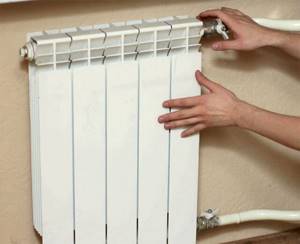
Air appears in batteries due to the following factors:
- Seasonal repair and maintenance work. At least once a year, the heating system must be checked and, if necessary, repaired. According to the instructions, you need to fill the circuit after replacing each structural element - but this will take too much water, so housing and communal services do not incur such costs.
- Replacement of heating devices. Another reason for the appearance of air in radiators is their replacement or removal by apartment residents. Of course, every discharge of the riser can cause it to become airy.
- Physical processes. When all the valves are closed and the pipeline is cooled, the volume of coolant contained in it decreases. If in such a situation you open at least one valve, the batteries will become airy, and you will have to think about how to bleed the air from the battery.
- Damage to system elements. The weakest link in the heating systems of apartment buildings are cast iron radiators, which, when the heating is turned off, begin to leak due to thermal expansion. At some point, you have to solve a serious problem - change all the batteries in the entrance or simply reset the system before the heating season begins.
Design and operating diagram of the crane
The Mayevsky crane consists of the following elements:
- housing, which is usually made of brass or steel with additional coating of zinc (chrome), which is resistant to high temperature and corrosion;
- a locking screw that allows you to open and close the device;
- inlet and outlet holes through which the air plug is removed.

Internal structure of the Mayevsky crane
To give the equipment a more aesthetic appearance, the case is closed with a plastic box.
The operating principle of this type of heating system fittings is as follows:
- if uneven heating of the battery is detected, the locking screw is turned;
- the shut-off screw opens the drain valve through which air is released;
- After bleeding is completed, the valve is closed by rotating the shut-off screw in the opposite direction.
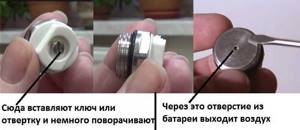
How the Mayevsky crane works
How to de-air aluminum, bimetallic and cast iron batteries
Depending on the material of the radiator, the gas removal procedure may differ:
- Aluminum batteries are famous for their low cost and high thermal conductivity. However, aluminum is not a very good option for making a heating device, because... it is capable of reacting with surrounding substances. As a result, this leads to the release of hydrogen. If airiness occurs in the aluminum battery, the problem is solved by using a Mayevsky crane. To remove hydrogen outside, a special film is used as an internal coating. Unfortunately, it has a limited validity period.
- Bimetallic batteries take a different approach: the internal surfaces of devices in direct contact with water are made of water-resistant metal. Aluminum is used to make the ribs. When using thermostats, this allows the system to be pumped and gas released.
- As a rule, a Mayevsky tap or an automatic air vent helps to bleed air from a cast iron battery.
